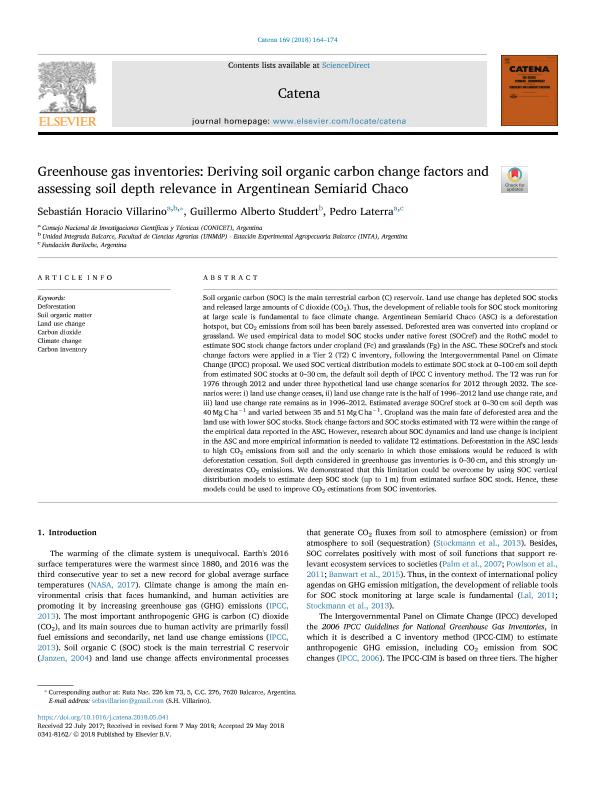Artículo
Greenhouse gas inventories: Deriving soil organic carbon change factors and assessing soil depth relevance in Argentinean Semiarid Chaco
Fecha de publicación:
02/06/2018
Editorial:
Elsevier Science
Revista:
Catena
ISSN:
0341-8162
Idioma:
Inglés
Tipo de recurso:
Artículo publicado
Clasificación temática:
Resumen
Soil organic carbon (SOC) is the main terrestrial carbon (C) reservoir. Land use change has depleted SOC stocks and released large amounts of C dioxide (CO2). Thus, the development of reliable tools for SOC stock monitoring at large scale is fundamental to face climate change. Argentinean Semiarid Chaco (ASC) is a deforestation hotspot, but CO2 emissions from soil has been barely assessed. Deforested area was converted into cropland or grassland. We used empirical data to model SOC stocks under native forest (SOCref) and the RothC model to estimate SOC stock change factors under cropland (Fc) and grasslands (Fg) in the ASC. These SOCref´s and stock change factors were applied in a Tier 2 (T2) C inventory, following the Intergovernmental Panel on Climate Change (IPCC) proposal. We used SOC vertical distribution models to estimate SOC stock at 0–100 cm soil depth from estimated SOC stocks at 0–30 cm, the default soil depth of IPCC C inventory method. The T2 was run for 1976 through 2012 and under three hypothetical land use change scenarios for 2012 through 2032. The scenarios were: i) land use change ceases, ii) land use change rate is the half of 1996–2012 land use change rate, and iii) land use change rate remains as in 1996–2012. Estimated average SOCref stock at 0–30 cm soil depth was 40 Mg C ha−1 and varied between 35 and 51 Mg C ha−1. Cropland was the main fate of deforested area and the land use with lower SOC stocks. Stock change factors and SOC stocks estimated with T2 were within the range of the empirical data reported in the ASC. However, research about SOC dynamics and land use change is incipient in the ASC and more empirical information is needed to validate T2 estimations. Deforestation in the ASC leads to high CO2 emissions from soil and the only scenario in which those emissions would be reduced is with deforestation cessation. Soil depth considered in greenhouse gas inventories is 0–30 cm, and this strongly underestimates CO2 emissions. We demonstrated that this limitation could be overcome by using SOC vertical distribution models to estimate deep SOC stock (up to 1 m) from estimated surface SOC stock. Hence, these models could be used to improve CO2 estimations from SOC inventories.
Archivos asociados
Licencia
Identificadores
Colecciones
Articulos(CCT - MAR DEL PLATA)
Articulos de CTRO.CIENTIFICO TECNOL.CONICET - MAR DEL PLATA
Articulos de CTRO.CIENTIFICO TECNOL.CONICET - MAR DEL PLATA
Articulos(CCT - PATAGONIA NORTE)
Articulos de CTRO.CIENTIFICO TECNOL.CONICET - PATAGONIA NORTE
Articulos de CTRO.CIENTIFICO TECNOL.CONICET - PATAGONIA NORTE
Citación
Villarino, Sebastián Horacio; Studdert, Guillermo Alberto; Laterra, Pedro; Greenhouse gas inventories: Deriving soil organic carbon change factors and assessing soil depth relevance in Argentinean Semiarid Chaco; Elsevier Science; Catena; 169; 2-6-2018; 164-174
Compartir
Altmétricas




